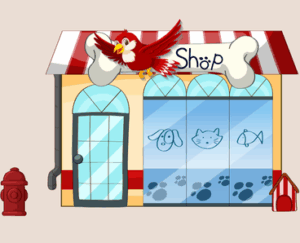This is a budgie, but how do you properly care for such a small bird? Well, first of all, your budgie obviously needs a good diet. This usually consists of seeds, pellets, veggies, and fruits. Your budgie might be picky and may not accept some veggies or fruits, but it’s still very important to offer something new every day until you find out what they like.

The budgie is a very playful creature that loves to fly around, chew on things, and destroy lots of toys. While we humans go to school, work, and watch TV, your budgie’s main occupation is to play with its toys. The budgie will accept almost any toy you offer, but stay away from lead and rope toys that can make your budgie ill. In the wild, budgies’ natural shelter is trees, but in your home, it would be its cage. Your budgie might be sat in a tiny and crowded cage, so upgrading to a bigger cage is always a good idea, giving it plenty of space to go about its daily business.
If you’ve just brought home your first budgie, or if you want to learn how to care for your budgie better, you’ll want to ensure it stays healthy and happy.
Budgie Birds Common Types Rare Colors
Budgigars are native birds to Australia and are among the most popular pet birds in the world. They are small in size but big in nature, being playful, curious and social. Due to their intelligence, they can imitate sounds, recognize people and can even learn simple tricks when appropriately trained.

- Breeds and Varieties: Budgies come in different breeds, varying in their size, temperament, and other aspects:
- Common Budgies: Small, very active and boisterous. Ideal for owners that like to be around people.
- English Budgies: Larger, sedate and useful for the beginner or family with children. They are more slowly growing but they also are gentle.
- American Budgie: Smart, very active and very social. They like toys and company and need more attention.
Colors and Patterns: Budgies are available in a variety of colors such as green, blue or yellow, white or pied colors. Some rare color variations such as grey or violet are highly sought after as they are in high demand from breeders. Budgies also have varying patterns on their feathers like spots, stripes and mosaics that make each bird different from the rest.
How to Take Care of Your Budgie
Being a good budgie owner means taking proper care of your bird so that he stays as healthy and happy (and alive) as possible.
- Food: The Budgie requires a varied diet. Seeds are not enough they need to be given in addition to pellets and fresh food. Spinach, broccoli and carrots are loaded with nutrients while apples, berries and melon make good indulgent treats. Do not allow access to avocado, chocolate caffeine or onions as these are toxic.
- Cage Selection: Select a cage large enough for climbing, hopping, and brief flights. Horizontal bars promote swing and are ideal for hanging. Provide perches of different sizes to help toughen feet, and position food and water dishes where the bird can easily access them. Do not over populate the cage, and keep it clean to avoid mess.
- Toys and Mental Stimulation: Budgies are known for the intellect and must be given with mental stimulation. Offer diverse toys such as ladder, swings bells mirrors and more. Rotating toys with frequency keeps it feeling fresh. A bored budgie will develop behavioral problems such as feather plucking and screaming too much.
Keep the cage in a secure cubicle with good lighting, and away from draughts, direct sunlight or noisy appliances. Budgies like companionship, so don’t put their cage in a room with no activity.
Understanding Budgie Behavior
Budgies do most of their talking through chirps, whistles and body language.

Sounds: When being happy birds, chirping is their normal mode of expression. While not all budgies will whistle tunes, talk or mimic household sounds, there are many that do. The more outgoing and social a budgie is, the louder he tends to be.
Body Language:
- Puffing up normally is a sign of being relaxed or pleased.
- Quick tail wags or head bobs can indicate excitement or interest.
- Beak grinding is for comfortable, particularly before sleeping.
- The ones you see striking are expressing stress, fear or other aggressive postures.
Habits: Budgies are lively little birds, In the wild they roam over large areas in search of food. They are social by nature and form pairs or flocks, although a single budgie will also become attached to its human. Listening, watching and learning will help you learn their tendencies and wants.
How to Hand Feed Your Baby Budgies
Whether you want to hand feed your budgies for bonding or the parents have stopped feeding them, here’s how to do it safely.

1. Preparing the Formula
- Choose a formula specifically intended for budgies.
- Follow the brand’s directions for mixing powder and water.
- Example: 1 teaspoon powder + 2.5 teaspoons water for a 5-day-old budgie.
- The consistency should be like applesauce.
- Temperature must be 103–108°F (39–42°C) to avoid digestion issues or burns. Use a thermometer for accuracy.
2. Feeding Your Budgies
- Place your budgie on a paper towel to catch any mess.
- Cup your hand loosely around their body to provide warmth and security.
- Place the syringe tip on the side of the beak and feed slowly.
3. How Much to Feed
- Budgies grow rapidly, so food intake increases with age:
- 2 weeks: 2–4 ml per feeding
- 3 weeks: 4–6 ml per feeding
- 5 weeks: 5–8 ml per feeding
- Check the crop by gently feeling it, it should feel slightly firm when full.
- Avoid overfeeding budgies may not know when to stop.
4. Feeding Frequency
- 2–3 weeks old: every 3–4 hours
- 4 weeks old: every 5 hours
- Ensure the crop fully empties before each feeding.
- A nightly rest of 8 hours is essential for digestion.
Beware: some foods like avocado, mushrooms, and chocolate are extremely toxic and might be deadly for your budgie.
Cleaning After Feeding
- Gently clean sticky or hardened feathers after each feeding.
- Use a Q-tip with warm water to remove excess food.
- Maintain a warm environment without drafts or AC to help digestion.
How to Gain Your Budgie’s Trust – 6 Tips for Taming
Hey everyone, Jamie Lee here from Bird Tricks! Today, we’re talking about how to gain your budgie’s trust.
Use Positive Reinforcement
Positive reinforcement means rewarding your bird with something it loves. For budgies, spray millet is often a favorite. Use treats to reward behaviors like:
- Coming to you
- Flying to a perch
- Going into its cage
Rewarding desired behaviors consistently helps your budgie associate you with positive experiences. Make sure your bird is on a proper diet so treats are meaningful.
Read and Respect Body Language
Understanding your budgie’s body language is key. Early on, it may just seem like your bird wants nothing to do with you, but as you learn subtle cues like signs before it flies away or becomes uncomfortable you’ll know when it’s ready to interact. The more sensitive you are, the more your budgie will trust you.
Focus on Quality Over Quantity
It’s not about how often you interact, but how meaningful each interaction is. Short, positive sessions are better than long sessions where your bird feels stressed or forced.
Associate Yourself with Food
Whenever your budgie interacts with you, offer a treat it loves. If your bird flies to your shoulder or comes close, reward it. Over time, your presence will be associated with positive experiences and treats.
Give Your Budgie Choice
Encourage your budgie to come to you rather than forcing interactions. Allowing it to choose when to interact strengthens trust and makes your budgie feel safe and comfortable around you.
How to Know Your Budgie’s Gender and Keep Them Healthy
Knowing what sex your budgie is will help you make breeding choices and decide on names based around sex. Males tend to have a blue cere (the flesh above the beak), while that of females is usually brown, or beige.
Health Tips:
- Give them fresh food and clean water each day.
- Excellent eyes on both beak and legs.Periodically check your birds’eyes, feathers, beak,feet etc.are in good condition for signs of illness.
- Feed a variety of seed, pellets, fruits and vegetables.
- Have an annual examination by a vet who specializes in birds to catch possible problems early.
Preventative Care: Provide adequate lighting, safe toys, and a clean cage. No smoking, harsh chemicals or poison plants in the vicinity of your bird. A happy budgie is one who is active, vocal and playful.
Fun Budgie Facts, Names, and Pop Culture
Budgies are entertaining and full of personality. Many can mimic human speech and household sounds, showing remarkable intelligence for their size.
Fun Facts:
- Budgerigars know their owner by sight and for that they will turn around to face you, add to the fact that they are clever enough although not as simple as cats or dogs in recognition.
- Budgies, both famous and not, can be found in cartoons, movies and on the shoulders of celebrities.
- They are a faviroute parrot species among bird enthusiasts and pet owners all around te world.
Popular Names: Kiwi, Bluebell, Sunny, Coco, Pip, and Sky. Choosing a unique or meaningful name can strengthen your bond.
Budgie Prices and Where to Buy Them Safely in UAE
Budgie prices in the UAE vary depending on breed, color, and age. Standard budgies usually cost AED 40 AED 200, while rare colors or special breeds can be more expensive.
Where to Buy in UAE
- Reputable breeders across the UAE who provide vaccinated and healthy birds.
- Verified pet stores with positive reviews and high standards of care.
- Rescue organizations or animal shelters offering adoption options.
Important Advice
Avoid buying from unreliable sources, unverified online marketplaces, or breeders without proper health checks. Ensuring your budgie comes from a healthy and clean environment is essential for its long-term happiness and well-being.
Frequently Asked Questions
Yes, budgies can eat grapes, but in small amounts. Grapes are safe and full of vitamins, but high in sugar. Give a few small pieces once or twice a week. Always wash them well and remove seeds before feeding.
Yes! Budgies need sunlight or UV light for vitamin D3, which keeps their bones strong. Give them 15–30 minutes of gentle, indirect sunlight daily. Avoid long exposure to direct heat.
Talk to your budgie daily using simple words like “hello.” Repeat the same words often and reward with treats. Short, fun sessions (5–10 minutes) work best. With time and trust, your budgie will start talking!
Beak grinding means your budgie feels calm and happy. They usually do it before sleeping. It’s a normal, healthy behavior like a cat’s purr!
Sit near your budgie, speak softly, and offer treats by hand. Once it feels safe, let it perch on your finger. Be gentle and consistent patience builds trust and tameness.






